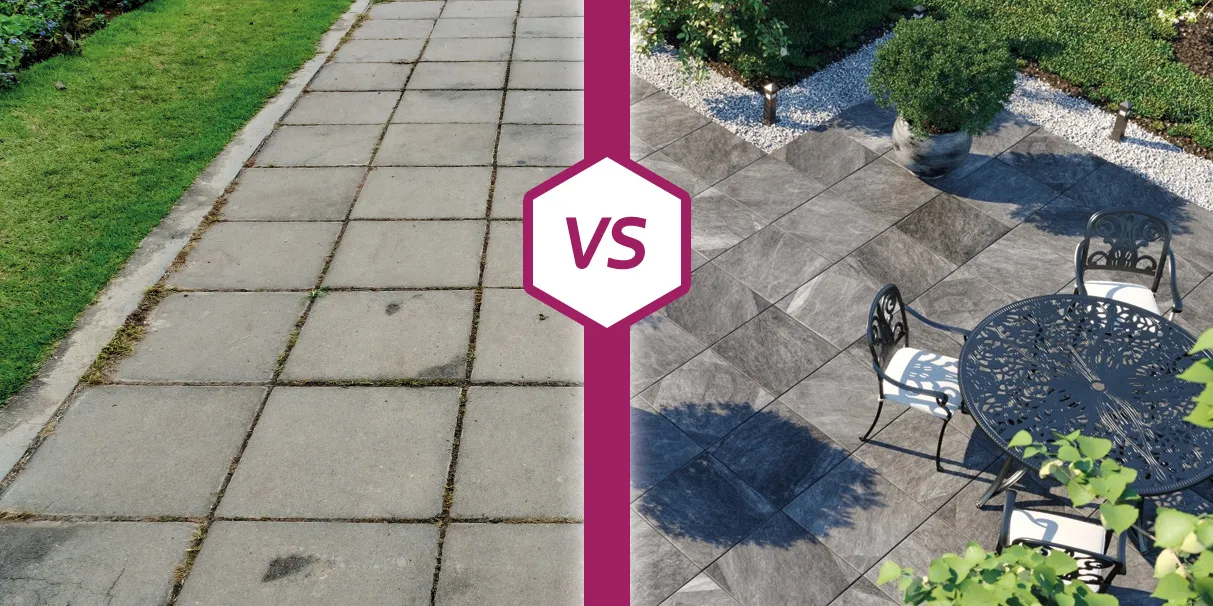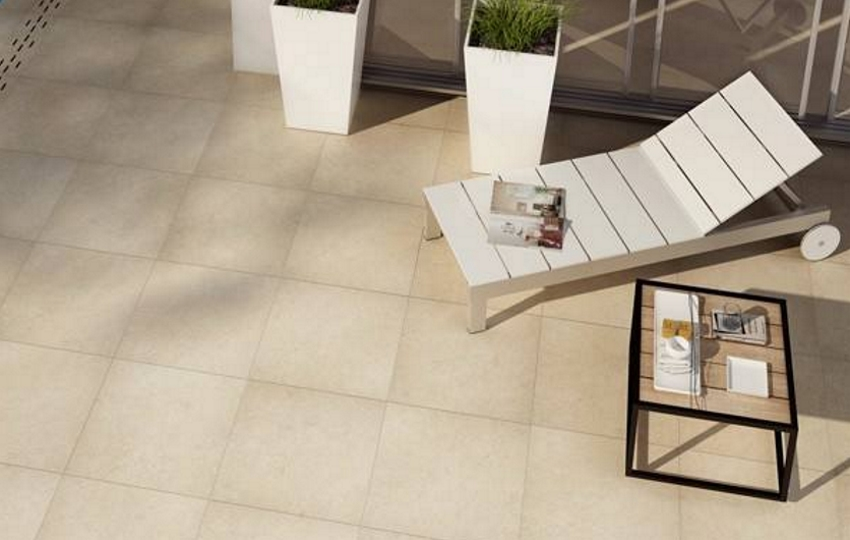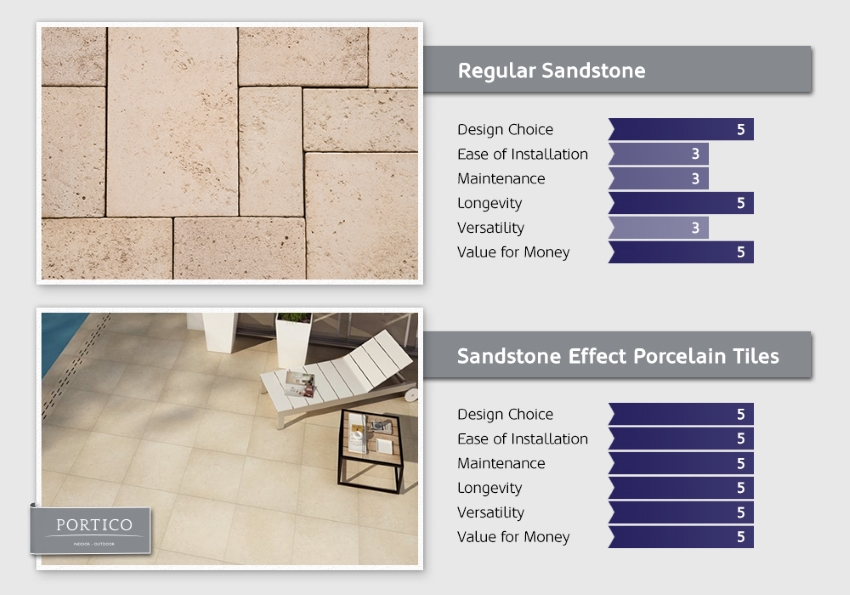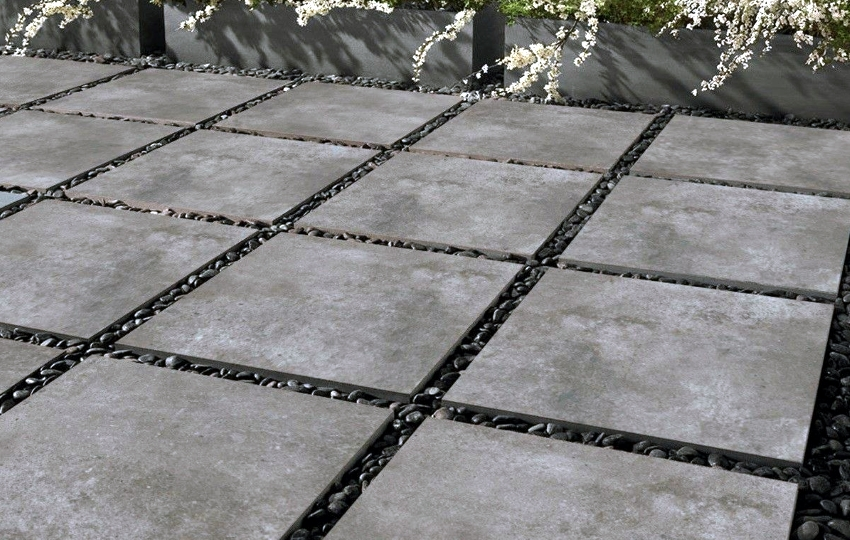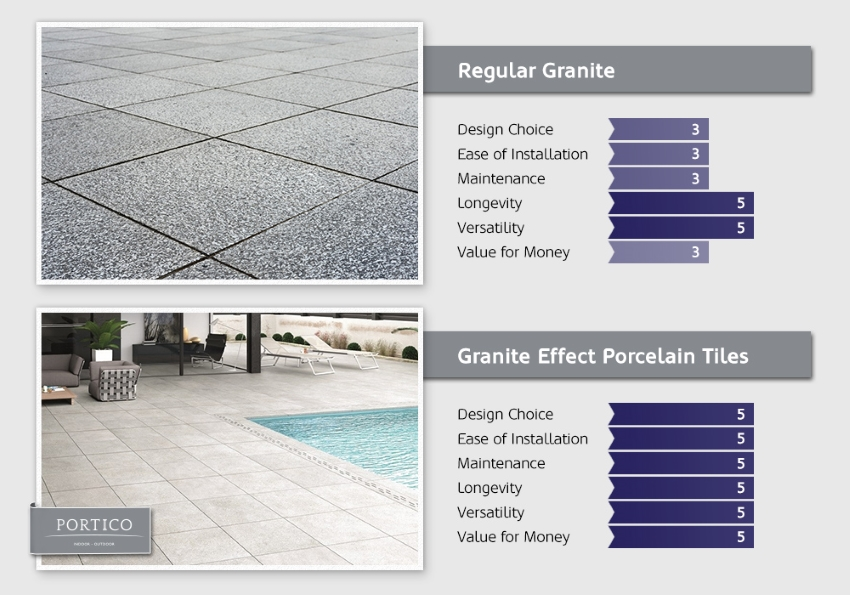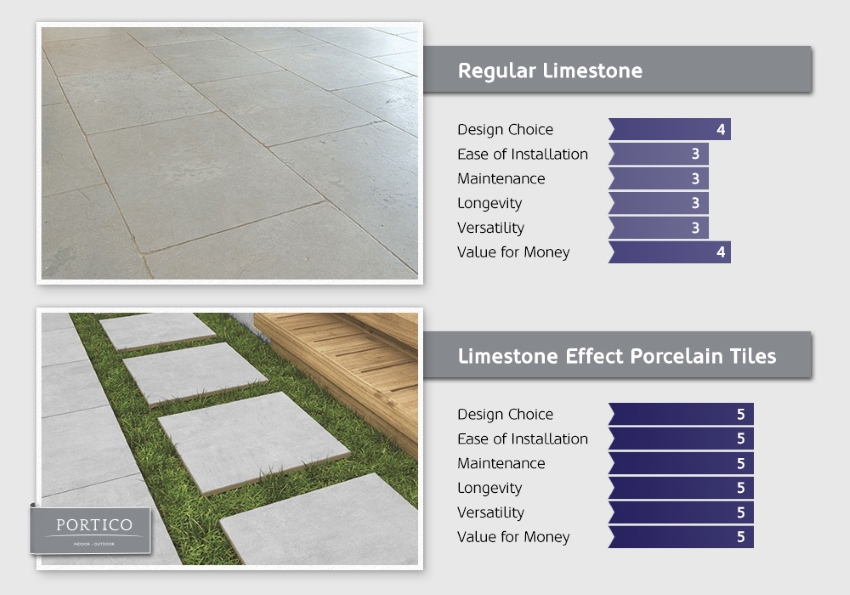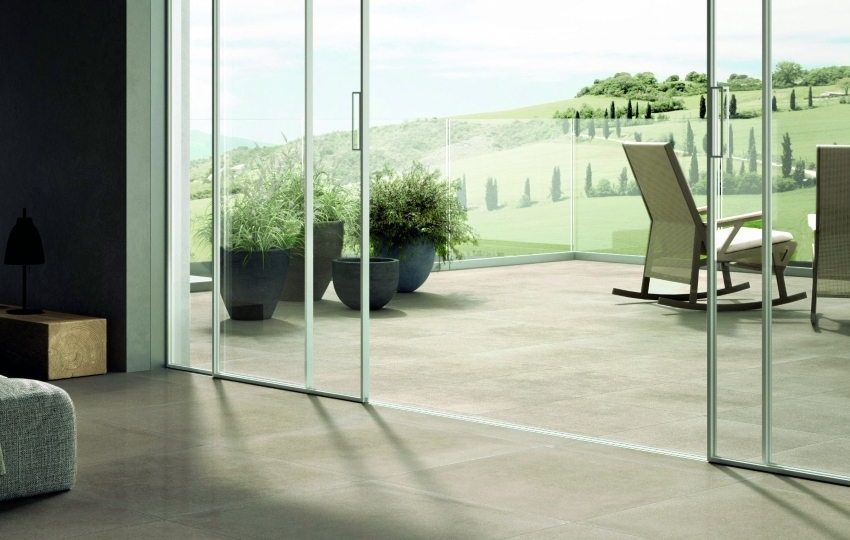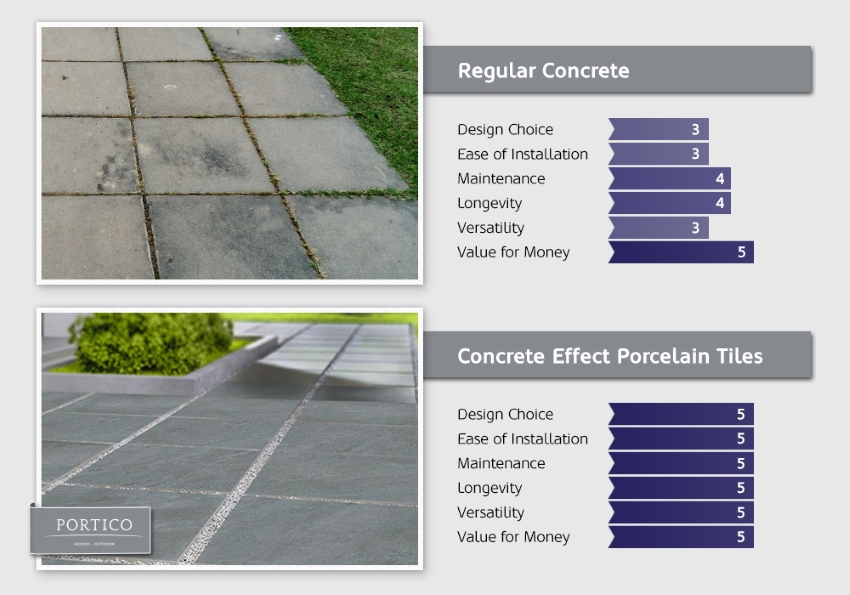Whilst paving slabs and block paving have been a staple choice for exterior flooring for centuries, outdoor tiles have grown massively in popularity in recent years, thanks in part to the burgeoning interior design trend of ‘indoor/outdoor’ which sees interior aesthetics in flooring seamlessly segueing into outside areas.
But why would you opt for tiles over a tried and tested product that’s been around for an absolute age? Well, read on dear friends as we’re about to pit specific categories of paving against their outdoor porcelain tile equivalents and weigh up the pros and cons of each in what we like to call Head To Head…
- Jump to Sandstone Effect Porcelain Tiles Vs Sandstone
- Jump to Granite Effect Porcelain Tiles Vs Granite
- Jump to Limestone Effect Porcelain Tiles Vs Limestone
- Jump to Concrete Effect Porcelain Tiles Vs Concrete
Sandstone Effect Porcelain Tiles Vs Sandstone
Sandstone flags have been a popular choice for homeowners for time immemorial, and it’s easy to see why when you consider their natural aesthetics and smooth surface texture. Effortlessly creating a subtle juxtaposition betwixt lush manicured lawns and shrubberies and flower beds that pop with colour, sandstone flags (especially modern variants) are a popular choice for gardens and areas attached to gardens in the UK.
In fact, there’s and increasing propensity for homeowners to dispense with lawns altogether and opt for contemporary styled sandstone across the board. However, whilst this look might be pleasing on the eye this type of flagstone can involve quite a lot of time-consuming upkeep.
Like any natural stone paving products, sandstone is quite porous, meaning that it’s susceptible to water absorption and the associated frost damage that comes with that. Another effect of moisture damage is dulling and fading, meaning that you’ll have to seal the flagstones post-installation (and annually after that) to prevent water ingress and guard against staining.
Whilst taking these steps will prolong the life of the flagstones’ and improve performance, their longevity still pales in comparison to that of sandstone effect porcelain slab tiles. This type of large format tile is virtually indistinguishable from the real thing yet don’t require post-installation sealing and keeping them in tip-top shape throughout the life of the product is as simple as washing down with Fila Tile & Stone Cleaner or mild detergent diluted in warm water every now and again.
When it comes to installation, both flagstones and porcelain slab tiles have their plus and minus points. Flagstones can be dry laid in sand or adhered with mortar onto a screed, both of which can take a lot of manual labour and specialist knowledge. The advantage of porcelain slab tiles however is that the adhesive used to fix them in place has specialist weatherproof qualities and will be less at risk from frost/moisture damage and will last longer. Also, the grout used can be matched to the colour of the slab tile, enabling a seamless look.
Granite Effect Porcelain Tiles Vs Granite
Ahh…Granite. The Rolls-Royce of the paving world, resplendent, opulent, millions of years in the making and redolent with earthy grandeur and understated ruggedness. It looks great, it’s durable, and it’s a great way of showing off your wedge because it costs a packet too. But what you mightn’t be aware of is that granite is perilously porous…
Yes, whilst granite is undoubtedly one of the hardest materials on the planet (second only to diamonds), like all natural stone, it can be ruined by moisture. Assuming you’re reading this in Blighty, you’ll know how much rain your average British garden is subjected to and so you might want to consider something that looks like granite but eschews the downsides. Something like large format granite effect porcelain tiles for example.
Porcelain is a type of ceramic manufactured finer grain clay and fired at much higher temperatures than ‘regular’ ceramic and it’s this process that gives it its durability and makes it less porous. Advanced HD printing technology used in the manufacture of granite effect tiles means that the same gentle, earthy tones exhibited by the igneous rock formed over millions of years are achievable too.
As genuine granite is a natural product, each slab will be unique and will exhibit random characteristics and shape – something that make a modern, uniform aesthetic difficult to achieve. Natural granite is also susceptible to scratches and fading due to UV exposure. Porcelain replication of granite often features rectified edges meaning that, when combined with colour-matched anti-mould grout, a sleek and contemporary look can easily be achieved.
It’s also worth remembering that whilst real granite can last for a lifetime when maintained properly, you’ll have to ensure that it is periodically sealed (especially if the area in which it’s installed is in direct contact with water) and mop up any spills straight away to prevent permanent staining. Granite effect porcelain tiles on the other hand are virtually maintenance free and do not require post-installation sealing and can be easily cleaned with warm soapy water or a specialist cleaning solution such as Fila Tile & Stone Cleaner or a pressure washer.
Finally, when choosing outdoor floor coverings it’s always a good idea to consider the scale of the project, the associated costs and the labour involved. Granite is very heavy and very hardwearing meaning that it’s difficult to cut and lift. As such, it’s advisable to use a professional installer (with granite experience) to ensure a good job is made. Whilst these sentiments also ring true for large format tiles, a competent DIYer could install this type of outdoor flooring without much fuss. Like granite though, porcelain slab tiles are quite thick and so a wet wheel tile cutter will be required.
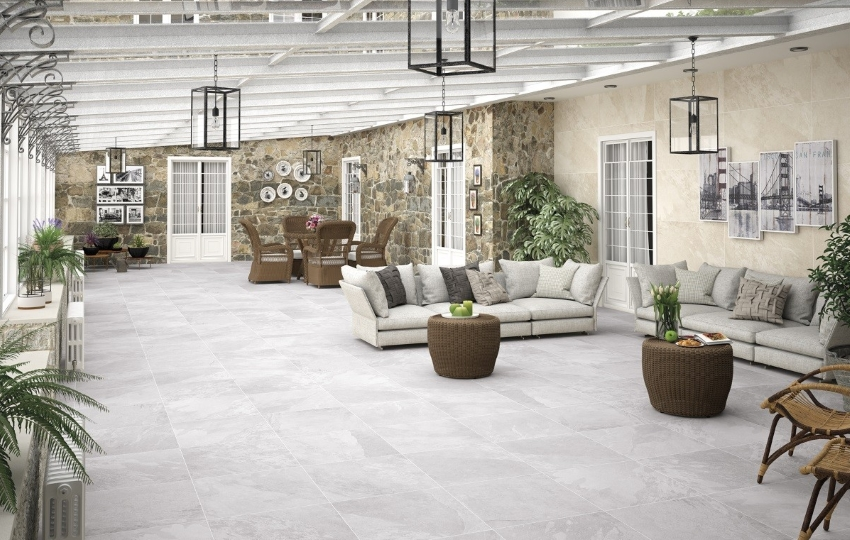
Limestone Effect Porcelain Tiles Vs Limestone
If natural, rustic charm is your thing then you can’t go wrong with limestone. If installed correctly and regularly maintained, limestone floors look stunning. It’s little wonder that this naturally occurring rock has been used as a building material for centuries – its durability and eye-catching natural shading, tones and textures are what makes it so attractive to homeowners.
However, with the risk of sounding like a broken record, this type of rock is porous and as such, requires quite a lot of looking after to prolong the life of the product. Aftercare is so important for limestone flooring and keeping on top of sealing is vital for avoiding stains. If sealed properly using a product such as Fila W68 Matt Stone Sealer, you can get a fair few years out of the first application but will still have to regularly ‘top up’ if the limestone is subjected to wet conditions. For these reasons, limestone is probably not the best choice for high-traffic areas or commercial applications.
As well as being incredibly attractive and offering a long-lasting non-slip surface with beautiful rustic aesthetics, limestone is less hassle to install than other natural stone products as it’s relatively soft and can be cut into bricks and slabs much easier. That said, it’s still quite heavy and specialist tools will be required to make a decent job of cutting, so it’s always best to enlist the help of a specialist stonemason when installing.
Conversely, limestone effect tiles offer all of the above plus points minus the drawbacks, so not only will you not have to worry about water absorption and constant sealing, you’ll be able to make cuts and install them yourself providing you have the right tools and a little DIY knowledge. Another advantage of limestone effect porcelain tiles is that, due to advancements in production techniques, shading can be controlled and tiles tailored to complement all manner of interior design styles.
Porcelain replication of limestone also allows a greater choice of finish – lappato, semi-lappato, matt and even gloss can are available – meaning that you can enjoy the aesthetics of the natural product but adapt the surface texture to suit your needs. This is particularly convenient if you’re installing in an area that is quite often wet (such as poolside) and want the reassurance an anti-slip rating provides.
Concrete Effect Porcelain Tiles Vs Concrete
The recent penchant for pared-back industrial style within design circles of late has seen concrete floors make a resurgence, both interiors and exteriors. Whereas in the past, plain old boring concrete would have been a utilitarian option for patios, driveways and paving, it’s now viewed in a different way and is the epitome of urban cool. As a result, we’re seeing it deployed in residential settings, especially where open-span interiors spill seamlessly into outdoor areas.
Concrete flooring comes in many incarnations including polished, brushed, scored, stamped, stained, and sealed varieties. These type of concrete floors however are both labour intensive, time-consuming, and expensive to install as they all involve the pouring of the concrete, curing, then finishing. As such, this type of concrete floor covering is usually reserved for public spaces, municipal buildings, and commercial installations.
For many of us, precast concrete ‘flags’ are the type of concrete paving with which we’re most familiar. These are sometimes known as ‘council flags’ and were widely used throughout the 1960, 70s, and 80s for standard street paving. These flags tend to come in standard variants as well as textured, exposed aggregate, pimpled and shot-blast textured versions. They’re quite versatile and widely available, but let’s be honest, they’re not the easiest on the eye and they’re a right rigmarole to transport and install.
You also won’t be surprised to hear that, you guessed it, they’re quite susceptible to water absorption and staining. Opting for porcelain tiles that replicate this type of paving can of course remedy this situation thanks to their low-maintenance, and the weatherproof attributes mentioned in the case of other ‘effect’ tiles. It’s also worth noting that concrete effect porcelain tiles are much, much easier to cut than the chunky 63-70mm thick ‘council flags’ and as such, easier to install.
Where large format concrete effect slab tiles steal a march on actual concrete slabs though is when used to create the popular indoor/outdoor look. Due to practicality and the levels of upkeep required (in terms of keeping them stain free), you wouldn’t really install genuine concrete slabs of any surface texture indoors and then continue with the same flooring material into exterior settings. Whilst you might try an opt for a similar-looking tile for interior areas then try to match them up with the slabs, there’s really no need to as many tiles from our Portico collection come with thicker exterior versions of their interior counterparts – check out the fantastic Dakota range for a great example of this.
So there you have it. It’s been a close run contest but we’d say that the large format porcelain slab tiles just about shade it. Of course, the type of paving you opt for will depend entirely upon what you want to achieve and how much time and effort you want to expend on installation.
It’s worth noting that all large format porcelain slab tiles can be installed using Adjustable Support Pedestals whereas some natural stone products cannot due to their lack of rectified edges. All installations that employ adhesives will require a nice, level substrate that has been properly cured before applying the mortar. You can learn more about installing large format porcelain outdoor tiles in our handy guide.
When it comes to cleaning, please be aware that some natural stone – limestone in particular – paving products can be damaged by citrus and acid-based cleaning products and should only be cleaned using PH neutral cleaning solutions such as Fila Tile & Stone Cleaner. All of the tiles in our Portico collection require nothing more than a rinse down with warm soapy water.
Let us know in the comments or hit us up on Facebook, Twitter, or Instagram if you need any further advice on which type of outdoor floor coverings to opt for. If you’ve already taken the outdoor tile plunge and want to share photos of a project completed using our Portico products, simply email them to myproject@tilemountain.co.uk and you could receive a £20 Amazon voucher for your troubles!
Here at Tile Mountain, we not only have a huge range of tiles to suit every purpose, we also have a wealth of tiling knowledge gained from over 30 years in the tile industry, (which we’ll do or best to share with you across these very pages).
Whether you’re looking for the perfect tiles for your next home improvement project, are searching for some style inspiration, or simply need a bit of help and advice, you’re in the right place.

